Danish Signaling, Entry Signals
DRAFT
Updated 991103

Contents
Introduction
Entry Signal Types
Main and Secondary
Lines (Speed Signaling Entry Signals)
Copenhagen
Suburban Lines
Non
Speed Signaling Entry Signals
Entry Signal Aspects and Indications
"Stop" (Danish: "Stop")
"Stop and
Proceed" (Danish: "Stop og Ryk Frem")
"Proceed" (Danish:
"Kør")
"Proceed at
reduced speed" (Danish: "Kør med begrænset hastighed")
"Proceed (at
high speed)" (Danish: "Kør (med høj hastighed)")
"Proceed Through"
(Danish: "Kør Igennem")
"Conditional
Stop" (Danish: "Betinget Stop") (Copenhagen Suburban lines only)
Entry Signal Usage
Speed Signaling
Advance
Signaling an Entry Block Signal
Aspects
for Diverging Through Routes
Aspects
for "Diverging" Entry Routes
Non
Speed Signaling Entry Signals
Copenhagen
Suburban lines
Peculiarities
Information
Signal (Danish: Underretningssignal), Copenhagen Suburban lines only
"Blind"
Entry Signals

Introduction
The Station Entry Signal is the Main Signal marking the borderline between
the line and the station limits. The Switch Limit Board marks the exit
from the station and onto the line. The Entry Signal protects the station
from trains on the line, and also governs train movements into or through
the station:

Basically, any "Proceed" aspect from an Entry Signal permits the train
to enter the station, being prepared to stop at the end of the entry route.
The end of the entry route may be marked by:
Except for a few situations regarding Entry Block Signals, the engineer
will have to use his route knowledge to determine where to expect to have
to stop at the station, since no clear advance signaling is given by the
Entry Signal. In practical terms, however, this is usually fairly straight-forward
on smaller stations. On larger stations the exact stopping point can only
be determined as the train enters the station. The examples below are simplified
regarding signal types and actual signal aspects, but sum up the main principles:



The "Proceed Through" aspect from an Entry Signal always means that
the route is clear through the station, and that the train may proceed
onto the line towards the next station. This is regardless of the number
of additional signals (if any) encountered through the station:


Entry Signal Types
Main and Secondary Lines (Speed Signaling Entry
Signals)
The speed signaling Entry Signal is by far the most common on the Danish
railways. Only relatively few (older) signal installations still feature
non
speed signaling Entry Signals. The standard Entry Signal is a
4-lamp signal, supplemented by either a
Symbol
Speed Indicator or a Reduced
Speed Sign. Entry Signals on stations without through running trains
lack the upper green lamp:




Entry Signals are supposed to have a yellow Station Name sign on the
mast, but this is only slowly being implemented. All non-passenger stations
have, however, had these signs for many years.
On stations where lines diverge, a "diversion arm" may be added to the
Entry Signal, featuring an extra green lamp, to facilitate the signal displaying
a "Proceed Through" aspect for the diverging line. Similarly, a "diversion
arm" with a yellow lamp (or both) may be used to indicate entry to a special
part of the station:



The diversion arm points in the direction of the diversion. In this
document, all diversion signals are shown with a diversion arm to the right.
Theoretically, an Entry Signal could have a diversion arm to both sides,
but this has never been implemented.
Copenhagen Suburban lines (Speed
Signaling Entry Signals)
Entry Signals on most parts of the Copenhagen Suburban lines deviate from
mainline signals by two extra yellow lamps. These lamps are used for the
special "Conditional Stop" (Danish: "Betinget Stop") aspect when running
on Cab Signals. Due to the extra space needed for the extra lamps, the
lower red and green lamps are pushed somewhat upwards. Otherwise the signals
are similar to mainline signals and generally capable of showing the same
signal aspects, for use by trains withy failed Cab Signal or trains not
equipped with Cab Signals. Signals on the Suburban lines cannot, however,
show "Stop and Proceed".




Most Entry Signals on the Suburban lines are only equipped with a Reduced
Speed Sign. A few signals are equipped with a Speed Indicator due to local
requirements, while another few have neither. Theoretically signals without
Reduced Speed Sign or Speed Indicator are non-speed signaling but they
are all used where only one, high speed, route is possible. Reduced Speed
Signs or Speed Indicators are only valid when used with Proceed aspects.
Non Speed Signaling Entry Signals
Some stations with older interlockings still feature Entry Signals incapable
of speed signaling. These installations become more and more rare as resignaling
takes place. The signals are a 3-lamp type for stations featuring Through
Route signaling and a 2-lamp type for other stations. These signals are
physically identical to similar Exit, Exit Block, Automatic Block and Protection
Signals. These signals are found on all types of lines. There is still
a single set of semaphore Entry Signals in operation at Borris station.



Entry Signal Aspects and Indications
The term Prescribed Speed, as used
below, is the speed prescribed in the Employee Timetable (Danish equivalent:
Tjenestekøreplanens Indledende Bemærkninger, TIB) or Track
Bulletins (Danish Equivalent: La).
Trains with active cab signals may receive
a more favorable indication than what lineside signals indicate. Cab signal
will govern in such cases.
"Stop" (Danish: "Stop"
"Stop and Proceed" (Danish: "Stop og Ryk Frem")
| |
 |
 |
 |
 |
 |
-
Stop, then proceed to the end of the Entry Route
|
X |
X |
X |
X |
X |
-
Maximum speed 40 km/h (25 mph)
|
X |
X |
X |
X |
X |
-
Entry Route cannot be guaranteed to be unoccupied
|
X |
X |
X |
X |
X |
-
Entry route is diverging in the direction of the upper lamp
|
|
|
|
|
X |
"Proceed" (Danish: "Kør")
| |
 |
 |
 |
|
|
X |
X |
X |
-
Stop at the station. On stations with Main Signals at the exit end, through
trains may omit stopping if signals permit them to proceed
|
X |
X |
X |
|
|
X |
X |
|
"Proceed at Reduced Speed" (Danish: "Kør
med begrænset hastighed")
| |
 |
 |
|
|
X |
X |
-
Stop at the station. Through trains may omit stopping if signals permit
them to proceed
|
X |
X |
|
|
X |
X |
| |
 |
 |
 |
-
Proceed on Entry Route at max. 40 km/h (25 mph)
|
X |
X |
X |
-
Stop at the station. Through trains may omit stopping if signals permit
them to proceed
|
X |
X |
X |
-
Entry route is diverging in the direction of the upper lamp
|
|
|
X |
|
|
X |
X |
X |
| |
 |
 |
 |
-
Proceed on Entry Route at max. 60 km/h (40 mph)
|
X |
X |
X |
-
Stop at the station. Through trains may omit stopping if signals permit
them to proceed
|
X |
X |
X |
-
Entry route is diverging in the direction of the upper lamp
|
|
|
X |
|
|
X |
X |
X |
| |
 |
 |
 |
-
Proceed on Entry Route at max. 40 km/h (25 mph). The Entry Route has no
safety overlap
|
X |
X |
X |
|
|
X |
X |
X |
-
Entry route is diverging in the direction of the upper lamp
|
|
|
X |
|
|
X |
X |
X |
"Proceed (at high speed)" (Danish: "Kør
(med høj hastighed)")
| Stations without Entry Block Signal only |
 |
 |
 |
 |
 |
|
|
X |
X |
X |
X |
X *) |
|
|
|
|
X
|
X
|
|
-
Stop at the station. Through trains may omit stopping if signals allow
them to proceed
|
X |
X |
X |
X |
X |
|
|
X |
X |
X |
X |
X |
*) Though technically a non speed signaling Entry Signal, this type is
only used where (high) line speed is permitted.
| Stations with Entry Block Signal only |
 |
 |
|
|
X |
X |
-
Entry Block Signal shows "Proceed (at high speed)" or better
|
X |
X |
-
Stop at the station. Through trains may omit stopping if signals allow
them to proceed
|
X |
X |
|
|
X |
X |
| Stations with Entry Block Signal only |
 |
 |
|
|
X |
X |
-
Prepare to stop at Entry Block Signal
|
X |
X |
|
|
X |
X |
"Proceed Through" (Danish: "Kør Igennem")
| |
 |
 |
 |
|
|
X |
X |
X |
|
|
|
|
X
|
-
Exit Signal (if any) shows "Proceed" or better. Any intermediate signals
show "Proceed Through"
|
X |
X |
|
-
Exit Signal shows "Proceed" or better. Any intermediate signals show "Proceed
Through"
|
|
|
X |
|
|
X |
|
X |
| |
 |
 |
 |
-
Proceed through station at prescribed speed.
Lowest permitted speed in the station entry end is 40 km/h (25 mph)
|
X |
X |
X |
-
Exit Signal shows "Proceed" or better. Any intermediate signals show "Proceed
Through"
|
X |
X |
X |
|
|
X |
X |
X |
-
Entry route is diverging in the direction of the upper lamp
|
|
|
X |
| |
 |
 |
 |
-
Proceed through station at prescribed speed.
Lowest permitted speed in the station entry end is 60 km/h (40 mph)
|
X |
X |
X |
-
Exit Signal shows "Proceed" or better. Any intermediate signals show "Proceed
Through"
|
X |
X |
X |
|
|
X |
X |
X |
-
Entry route is diverging in the direction of the upper lamp
|
|
|
X |
| Stations without Entry Block Signal only |
 |
 |
 |
 |
-
Proceed through station at prescribed speed
Lowest permitted speed in the station entry end is 75 km/h (45 mph) or
higher
|
X |
X |
X |
X *)
|
-
Exit Signal shows "Proceed" or better. Any intermediate signals show "Proceed
Through"
|
X |
X |
X |
X
|
|
|
X |
X |
X |
X
|
-
Entry route is diverging in the direction of the upper lamp
|
|
|
X |
|
*) Though technically a non speed signaling Entry Signal, this type is
only used with high line speed.
| Stations with Entry Block Signal only |
 |
 |
 |
-
Proceed through station at prescribed speed.
Lowest permitted speed in the station entry end is 75 km/h (45 mph) or
higher
|
X |
X |
X |
-
Entry Block Signal shows "Proceed through (at high speed)"
|
X |
X |
X |
-
Exit Signal shows "Proceed" or better. Any intermediate signals show "Proceed
Through"
|
X |
X |
X |
|
|
X |
X |
X |
-
Entry route is diverging in the direction of the upper lamp
|
|
|
X |
| Stations with Entry Block Signal only |
 |
 |
 |
-
Proceed through station at prescribed speed.
Lowest permitted speed to the Entry Block Signal is 75 km/h (45 mph) or
higher
|
X |
X |
X |
-
Entry Block Signal shows "Proceed through (at reduced speed)"
|
X |
X |
X |
-
Exit Signal shows "Proceed" or better. Any intermediate signals show "Proceed
Through"
|
X |
X |
X |
|
|
X |
X |
X |
-
Entry route is diverging in the direction of the upper lamp
|
|
|
X |
"Conditional Stop" (Danish: "Betinget Stop")
(S-bane only)
| |
 |
 |
 |
-
Trains without active Cab Signal: Stop
|
X |
X |
X |
|
|
X |
X |
X |
Entry Signal Usage
Speed Signaling
A number of factors determine the permitted entry speed into a given station.
The factors are
-
Track conditions, e.g. turnout through switches, general speed restrictions,
curvature etc.
-
The length of the entry route
-
The length of the entry route safety overlap
The permitted entry speed for a given entry route is the lowest of the
speeds derived from the above considerations.
Speed determined by the right-of-way
The most usual reason for restricting the entry speed is the turnout through
switches. Generally, entry to main track is at high (line) speed, while
entry to other tracks is at lower speed:


Speed to indicate the entry route length
Entry speed may also be used to distinguish between entry routes of different
length. The permitted speed does not necessarily reflect a speed necessitated
by the actual length of the entry route, but is instead often chosen as
a low speed to warn the engineer of the shorter-than-normal entry route.
Below is indicated how low speed entry routes can be implemented to an
inner Platform Exit Signal :



Speed determined by the safety overlap
Permitted entry speed also relates to the length of the safety overlap.
Usually the safety overlap length is sufficient for whatever speed is permitted
for the above reasons, but some newer interlocking systems offer a choice
for entry routes with different safety overlap lengths. A short safety
overlap on a long entry route may be chosen to permit a long train into
the station, without blocking switches in the exit end of the station.
The short safety overlap restricts the permitted entry speed accordingly:

A special case of short overlap is the "Entry Route without Overlap".
The "Enty Route without Overlap" is used in situations where the entry
route is either significantly shorter than other entry routes and/or has
no safety overlap. Further examples of the use of this signal aspect can
be found in Special Entry Routes
:

Advance Signaling an Entry
Block Signal
On stations with an Entry Block Signal, the Entry Signal must advance signal
the Entry Block Signal. For a thorough explanation of this advance signaling,
please refer to the Entry
Block Signal document .
Aspects for Diverging Through Routes
The "Proceed through" aspect from an Entry Signal unambigously indicates
a unique through route through the station. On junctions where lines diverge,
it is therefore necessary to be able to clearly distinguish between through
routes to the different lines. This is accomplished by adding a "diversion
arm" to the entry signals, allowing it to show "Proceed Through" as two
diagonal green lamps, the direction of the upper lamp indicating the direction
of diversion.
Diversion point in entry end of station



"Proceed through" indicates that the train is permitted to run at line
speed. The permitted speed indicated on the Entry Signal is the lowest
permitted speed in the entry part of the station, and is not necessarily
valid starting from the Entry Signal.
Ordinary signal aspects are usually used for entry routes and for through
signaling on other than the through routes:



Diversion point in exit end of station
On stations with the diversion point in the exit end of the station, entry
speed to both through routes may be line speed:




Higher speed switches
Since speed signaling from Entry Signals only permits speeds of 40 km/h,
60 km/h and line speed, the introduction of 1:19 (#19) switches - permitting
100 km/h - has called for some special solutions. At the introduction of
bidirectional running it was decided that crossing between bidirectional
tracks should not be supported by diverging Entry Signal aspects (see above).
One such solution is the so called "Høje Taastrup" solution,
named after station to which it was invented. The example shown here is
the station containing the 1:19 crossovers at Sprogø on the Great
Belt Link, featuring the Høje Taastrup solution:

The Høje Taastrup solution restricts the entry speed from an
Entry Signal showing "Proceed" at high speed to 100km/h, using this aspect
for both branches of the crossover:


Trains through the station usually receives "Proceed Through", and are
permitted to run at line speed (160 km/h - 100 mph - in this case):

But trains crossing over to the other main track only receive "Proceed"
from the Entry Signal, thus still permitting 100 km/h:

This solution also respects the principle of a through routes to be
unambiguous, even though the advance signaling is just as needed when entering
the slow as the fast tracks. The Automatic Train Control system may support
a "Diverging Proceed Through" aspect, though this is not actually shown
to the train.
Aspects for "Diverging" Entry Routes
In some situations it is unfortunate, though not necessarily hazardous,
if a train ends up in the wrong part of a station. To prevent some of these
situations, an Entry Signal may be configured to show "Proceed" (at reduced
speed) aspects using a "diversion arm" like for "Proceed through". The
situations are:
-
Where the train would end up on a wrong line if it enters the station on
the set route
-
Where the train would end up in a separate part of the station with no
or difficult way back
-
Where an electric train would leave electrified tracks
Ending up on the right line:
On some open-line junction stations (i.e. not connected with other services)
the track layout is very simple. At these junctions it is crucial that
the train is routed to the right line already when entering the station:





Entry to special part of station
On some stations, diverging "Proceed" aspects are used to signal entry
to a designated part of the station. The designated part of the station
can be, say, a freight yard. In the example below, entry is possible to
the freight yard (lowest two tracks), to the Entry
Block Signal or directly (via the upper track) to the platforms:

Entry to the freight yard is signaled via a diverging "Proceed" aspect:

Entry to the other part of the station follows the general rules and
uses ordinary "Proceed" aspects:


Entry to non-electrified track
Diverging "Proceed" aspects are also used where entry from an electrified
line to a non-electrified track is possible, or from one electrification
system to another. The example below shows a non-electrified freight yard
on an electrified line:


Non Speed Signaling Entry Signals
A few stations still feature Entry Signals without the capability to display
the permitted entry speed. These installations date back to the time before
1961, where the track usage at each station was listed in the employee
timetable, thus also listing the permitted entry speed. Non speed signaling
Entry Signals are today only used on secondary lines and in a few locations
where only one entry route is possible from the signal.
On some secondary lines, the entry speed from a signal showing "Proceed"
has been fixed as a common (lowest) speed to any track on the station.
Other secondary lines still use the old rule of fixed track utilization.
In both cases, the "Proceed Through" aspect permits line speed:
|
Common entry speed:
|
Fixed use of tracks:
|

|

|
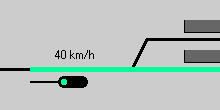
|
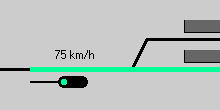
|

|

|
Copenhagen Suburban lines
The special "Conditional Stop" aspect is used on the Copenhagen Suburban
lines, in conjunction with the so called HKT (Danish for "HastighedsKontrol
og Togstop" - "Speed Check and Train stop". Using the cab signaling system,
trains do not use lineside signals. Entry, Exit and Automatic Block Signals
all show the "Conditional Stop" aspect to trains permitted to proceed on
cab signal indication. "Conditional Stop" does not necessarily indicate
that the route is clear to the next Entry, Platform Exit, Exit or Automatic
Block Signal, only to the next HKT
Stop Marker.
On stations, the HKT Stop Marker can also be located at Dwarf Signals:
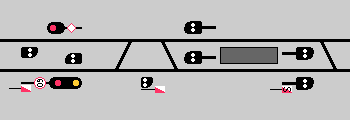
These Dwarf Signals are then used as a sort of Entry/Exit Block Signals
for trains running on cab signal indication:
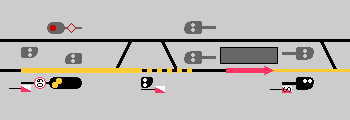
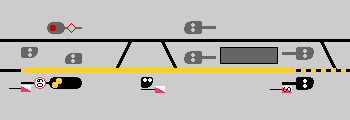
Trains with failed cab signals are run using ordinary signal aspects
from an Entry, Platform Exit, Exit or Automatic Block Signal to the next:
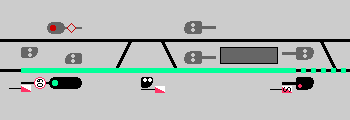
Peculiarities
Information Signal (Danish: Underretningssignal),
Copenhagen Suburban lines only
On a few junctions on the Copenhagen Suburban lines the Entry Signal has
been supplemented with an Information Signal. The purpose of the Information
Signal is to provide the same type of information as the diversion "arm"
on mainline signals. As Entry Signals on the Copenhagen Suburban lines
usually show "Conditional Stop", the signal aspect itself cannot convey
any route information; hence the need for the Information Signal.

The Information Signal can show a white line of lights, from bottom
to top diverging in the direction of the route. If the Entry Signal shows
"Proceed" to a route ending before the diversion point, the Information
Signal is switched off. The following are examples of Information Signal
usage:








Only 2 Information Signals are installed, one for a diversion point
in the entry end of the station, the other for a diversion point at the
exit. Below is illustrated the diversion at the entry end of the station,
as it is used on Svanemøllen station:
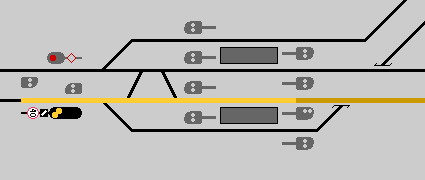
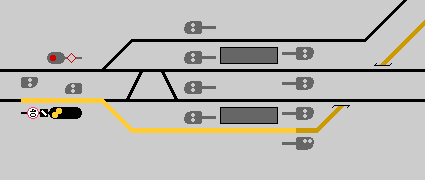
"Blind" Entry Signals
Since the Wrong Main Entry Signal was
declared obsolete, ordinary Entry Signals have been used instead. Many
(particularly older) station interlocking systems, however, do not feature
wrong main entry routes. The resulting Entry Signal is therefore a "blind"
signal, only marking the station limit by displaying the "Stop" aspect.
The signal may only be passed by verbal permission.



![]()






































































































































![]()
![]()